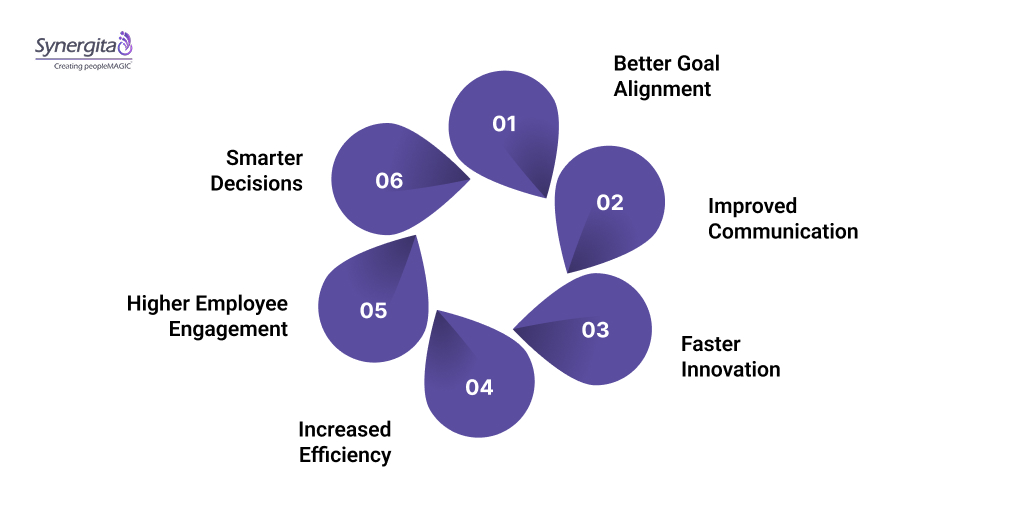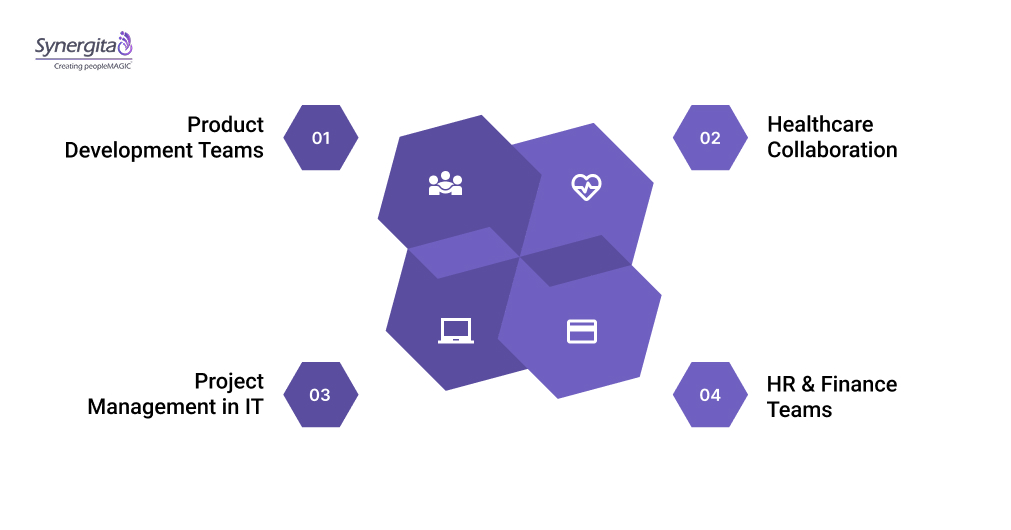Many teams still work in silos, making it hard to communicate, share ideas, or move projects forward efficiently. This often leads to missed deadlines, duplicated work, and a lack of clarity about who’s responsible for what. When teams operate separately, innovation slows down and productivity takes a hit.
Cross-functional collaboration brings people from different departments together to work toward a shared goal. Whether it’s launching a new product or improving a process, collaboration between teams leads to smarter decisions and faster results.
This blog explores the key benefits, real-world examples, and actionable steps to help you build stronger cross-functional teams.
Key Takeaways
- Cross-functional collaboration helps break down silos and align teams toward common goals.
- It drives innovation, accountability, and efficiency across departments.
- Real-world examples show how teams use collaboration to solve problems faster.
What Is Cross-Functional Collaboration?
Cross-functional collaboration means bringing together people from different departments—like marketing, HR, and product—to work on shared goals. Instead of focusing only on departmental outcomes, everyone works as one team.
It’s more than just communication. It’s about sharing accountability, aligning goals, and building a sense of ownership.
Also Read: Collaborative Work Management in 2025: Platforms & Trends
In modern workplaces where teams are remote or hybrid, this approach helps reduce confusion, improve coordination, and deliver better results.
Why Cross-Functional Collaboration Matters for Modern Organizations
When teams operate independently, priorities clash, and decisions take longer. Managers spend more time resolving conflicts than driving progress. This disconnection also affects employee engagement and team morale.
Cross-functional collaboration solves this by aligning everyone around a common purpose. It improves visibility, speeds up decision-making, and helps teams stay focused on results rather than tasks. For managers, it’s a powerful way to improve coordination and encourage accountability across departments.
Cross-functional collaboration can help you connect departments, boost accountability, and drive results that truly impact your business performance.
Key Benefits of Cross-Functional Collaboration
As a manager, cross-functional collaboration helps you to bring your whole team together. Here are the key benefits you can gain from fostering collaboration across departments.

- Better Goal Alignment: When teams share objectives, everyone works toward the same outcome. It ensures clarity and prevents duplicated effort.
- Improved Communication: Regular interaction between departments helps clear misunderstandings early and improves decision-making.
- Faster Innovation: Different perspectives lead to creative solutions. Cross-functional teams often spot opportunities that siloed teams miss.
- Increased Efficiency: Collaboration reduces rework, ensures resources are shared effectively, and keeps projects moving forward.
- Higher Employee Engagement: Employees feel valued when their contributions impact broader goals, leading to better motivation and job satisfaction.
- Smarter Decisions: With input from multiple functions, teams make data-driven and well-rounded decisions.
Also Read: How to Improve Cross-Functional Communication and Boost Team Performance
While cross-functional collaboration offers numerous benefits, it’s not without its challenges.
Common Challenges in Cross-Functional Collaboration
While collaboration sounds great in theory, it can be tricky to manage. Let’s explore some of the common hurdles that can arise and how you can address them effectively.
- Misaligned Priorities: Teams may have different goals that conflict with each other.
- Communication Gaps: Without a clear system, messages get lost, and confusion grows.
- Undefined Roles: Lack of role clarity causes delays and frustration.
- Technology Silos: Using disconnected tools prevents teams from tracking progress effectively.
- Leadership Barriers: Managers focused only on departmental results may unintentionally block cross-team progress.
The key is to address these challenges early by creating shared goals and communication systems that keep everyone aligned.
Real-World Examples of Cross-Functional Collaboration
To better understand the impact of cross-functional collaboration, let’s look at some real-world examples where teams from different departments came together to achieve remarkable results.

- Product Development Teams: Marketing, sales, and engineering teams work together to launch new products faster and ensure they meet customer needs.
- Healthcare Collaboration: Doctors, IT specialists, and administrators collaborate to improve patient care through shared data systems.
- Project Management in IT: Design, QA, and client support teams coordinate to deliver projects smoothly and on time.
- HR and Finance Teams: They work together to forecast budgets, manage workforce costs, and improve hiring efficiency.
These examples show how collaboration can turn scattered efforts into measurable business outcomes.
How to Build Strong Cross-Functional Teams
Here are some practical steps you can take to build strong cross-functional teams that are aligned, efficient, and driven toward shared goals.
- Define Shared Objectives: Set clear goals that connect all departments to the company’s vision.
- Assign Clear Roles: Everyone should know what they are responsible for to avoid confusion.
- Encourage Transparent Communication: Use regular updates, shared dashboards, and open discussions.
- Promote Trust and Accountability: Recognize team wins and highlight contributions across departments.
- Use the Right Tools: Use OKRs and continuous feedback tools to align and track performance across teams.
Also Read: How to Motivate Employees in the Workplace: 9 Strategies That Actually Work
Once you’ve established cross-functional teams, it’s important to track their success. Let’s explore how you can measure the impact of collaboration to ensure it’s driving the desired outcomes.
Measuring the Impact of Cross-Functional Collaboration
Tracking progress is essential to see if collaboration is working. You can measure success using metrics like:
- Project completion rate
- Team engagement scores
- Process efficiency and cost savings
- Innovation outcomes (new ideas, products, or improvements)
Regular performance reviews and data-driven insights help identify what’s working and where collaboration can improve.
To make collaboration measurable and goal-oriented, Synergita offers OKR and continuous feedback tools that connect teams across departments. Managers can align goals, monitor progress in real time, and ensure every function contributes to shared success—all within one platform.
Conclusion
Cross-functional collaboration helps organizations work smarter by connecting people, goals, and ideas across departments. It improves communication, encourages innovation, and helps teams stay focused on what really matters—achieving shared success.
By building clear goals, tracking performance, and fostering accountability, your organization can create stronger, more agile teams.
Ready to align your teams and drive collaboration that delivers results? Book a demo with Synergita today and see how it can help you build high-performing cross-functional teams.
FAQs
1. What is cross-functional collaboration?
It’s when people from different departments work together toward a shared goal, combining their expertise to solve problems faster and more effectively.
2. Why is cross-functional collaboration important?
It improves communication, reduces duplication, and helps teams make better decisions by bringing diverse perspectives together.
3. What are the main benefits of cross-functional collaboration?
Key benefits include better goal alignment, faster innovation, stronger engagement, and improved team efficiency.
4. What challenges do cross-functional teams face?
Common challenges include misaligned priorities, poor communication, unclear roles, and leadership barriers between departments.
5. How can technology improve cross-functional collaboration?
Tools like Synergita help teams align objectives, track progress, and share feedback, creating transparency and accountability across all departments.


